Health of Adults: Case Study Analysis and Nursing Care Plan
VerifiedAdded on 2023/06/08
|13
|2973
|161
AI Summary
This case study analysis discusses the medical conditions of a patient named Mrs. Marla Anthony who is 35 years of age and has been admitted to the hospital. The paper describes the nursing care plan and the inter-professional healthcare model that can be applied to offer the patient with maximum care.
Contribute Materials
Your contribution can guide someone’s learning journey. Share your
documents today.
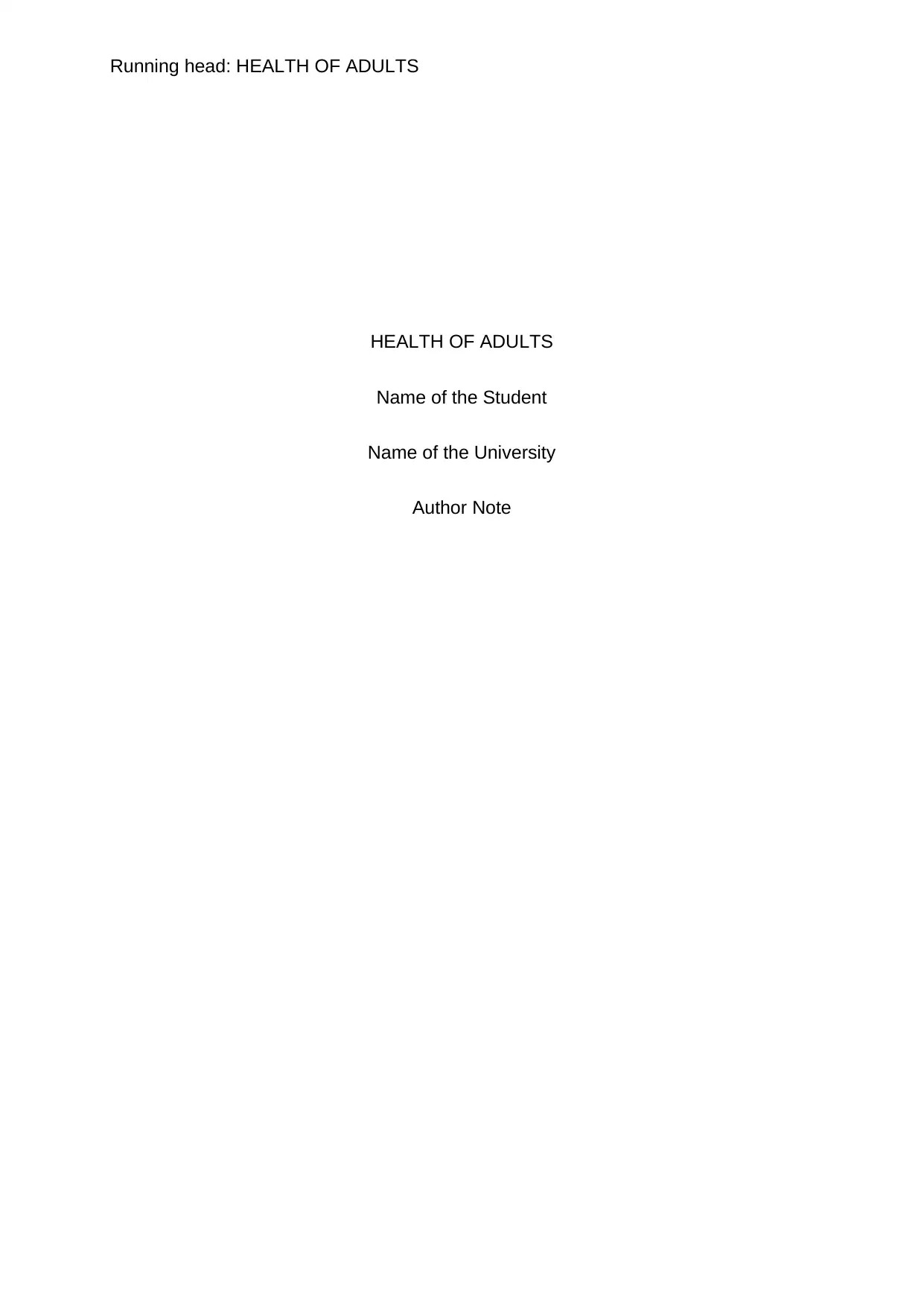
Running head: HEALTH OF ADULTS
HEALTH OF ADULTS
Name of the Student
Name of the University
Author Note
HEALTH OF ADULTS
Name of the Student
Name of the University
Author Note
Secure Best Marks with AI Grader
Need help grading? Try our AI Grader for instant feedback on your assignments.
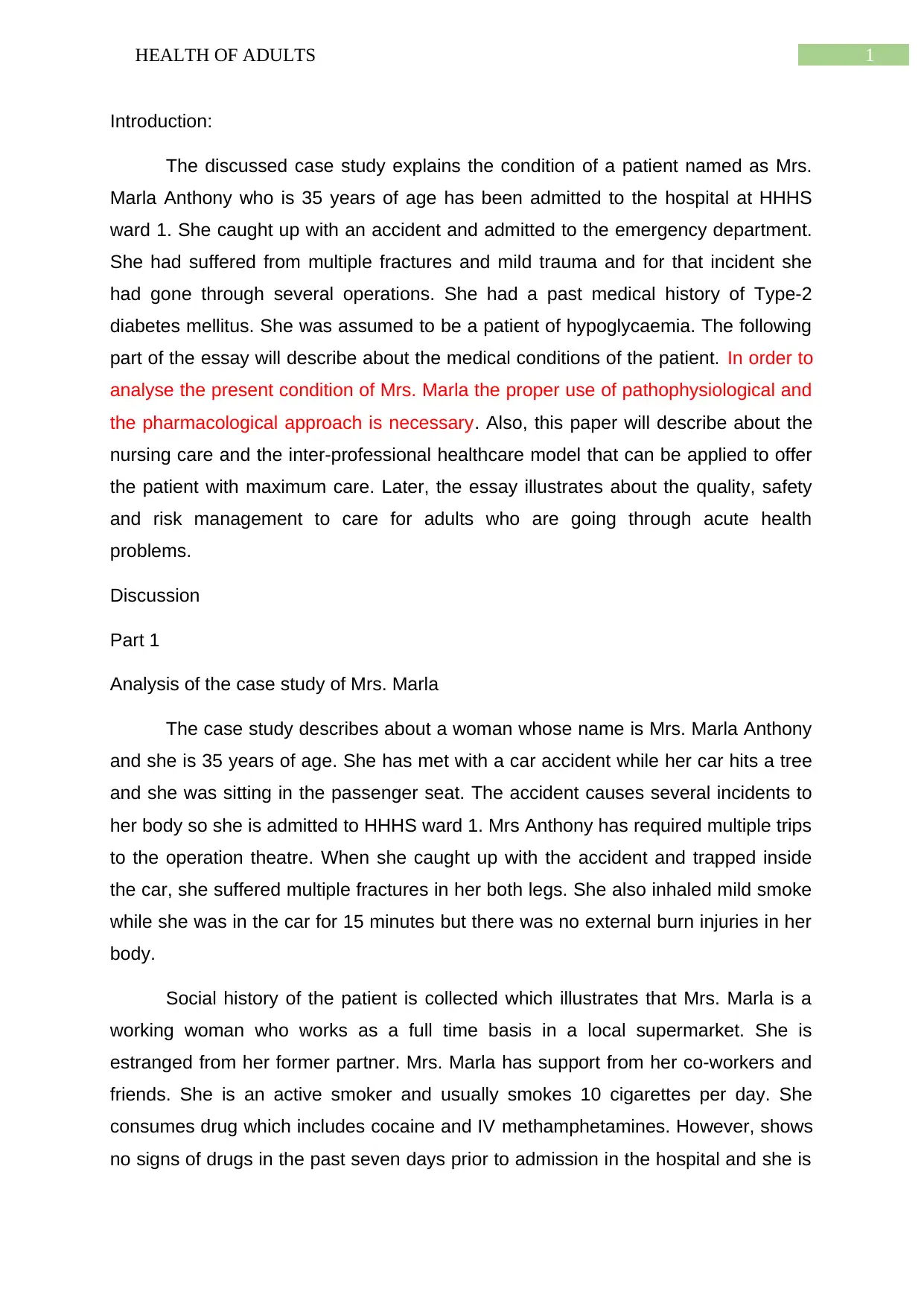
1HEALTH OF ADULTS
Introduction:
The discussed case study explains the condition of a patient named as Mrs.
Marla Anthony who is 35 years of age has been admitted to the hospital at HHHS
ward 1. She caught up with an accident and admitted to the emergency department.
She had suffered from multiple fractures and mild trauma and for that incident she
had gone through several operations. She had a past medical history of Type-2
diabetes mellitus. She was assumed to be a patient of hypoglycaemia. The following
part of the essay will describe about the medical conditions of the patient. In order to
analyse the present condition of Mrs. Marla the proper use of pathophysiological and
the pharmacological approach is necessary. Also, this paper will describe about the
nursing care and the inter-professional healthcare model that can be applied to offer
the patient with maximum care. Later, the essay illustrates about the quality, safety
and risk management to care for adults who are going through acute health
problems.
Discussion
Part 1
Analysis of the case study of Mrs. Marla
The case study describes about a woman whose name is Mrs. Marla Anthony
and she is 35 years of age. She has met with a car accident while her car hits a tree
and she was sitting in the passenger seat. The accident causes several incidents to
her body so she is admitted to HHHS ward 1. Mrs Anthony has required multiple trips
to the operation theatre. When she caught up with the accident and trapped inside
the car, she suffered multiple fractures in her both legs. She also inhaled mild smoke
while she was in the car for 15 minutes but there was no external burn injuries in her
body.
Social history of the patient is collected which illustrates that Mrs. Marla is a
working woman who works as a full time basis in a local supermarket. She is
estranged from her former partner. Mrs. Marla has support from her co-workers and
friends. She is an active smoker and usually smokes 10 cigarettes per day. She
consumes drug which includes cocaine and IV methamphetamines. However, shows
no signs of drugs in the past seven days prior to admission in the hospital and she is
Introduction:
The discussed case study explains the condition of a patient named as Mrs.
Marla Anthony who is 35 years of age has been admitted to the hospital at HHHS
ward 1. She caught up with an accident and admitted to the emergency department.
She had suffered from multiple fractures and mild trauma and for that incident she
had gone through several operations. She had a past medical history of Type-2
diabetes mellitus. She was assumed to be a patient of hypoglycaemia. The following
part of the essay will describe about the medical conditions of the patient. In order to
analyse the present condition of Mrs. Marla the proper use of pathophysiological and
the pharmacological approach is necessary. Also, this paper will describe about the
nursing care and the inter-professional healthcare model that can be applied to offer
the patient with maximum care. Later, the essay illustrates about the quality, safety
and risk management to care for adults who are going through acute health
problems.
Discussion
Part 1
Analysis of the case study of Mrs. Marla
The case study describes about a woman whose name is Mrs. Marla Anthony
and she is 35 years of age. She has met with a car accident while her car hits a tree
and she was sitting in the passenger seat. The accident causes several incidents to
her body so she is admitted to HHHS ward 1. Mrs Anthony has required multiple trips
to the operation theatre. When she caught up with the accident and trapped inside
the car, she suffered multiple fractures in her both legs. She also inhaled mild smoke
while she was in the car for 15 minutes but there was no external burn injuries in her
body.
Social history of the patient is collected which illustrates that Mrs. Marla is a
working woman who works as a full time basis in a local supermarket. She is
estranged from her former partner. Mrs. Marla has support from her co-workers and
friends. She is an active smoker and usually smokes 10 cigarettes per day. She
consumes drug which includes cocaine and IV methamphetamines. However, shows
no signs of drugs in the past seven days prior to admission in the hospital and she is
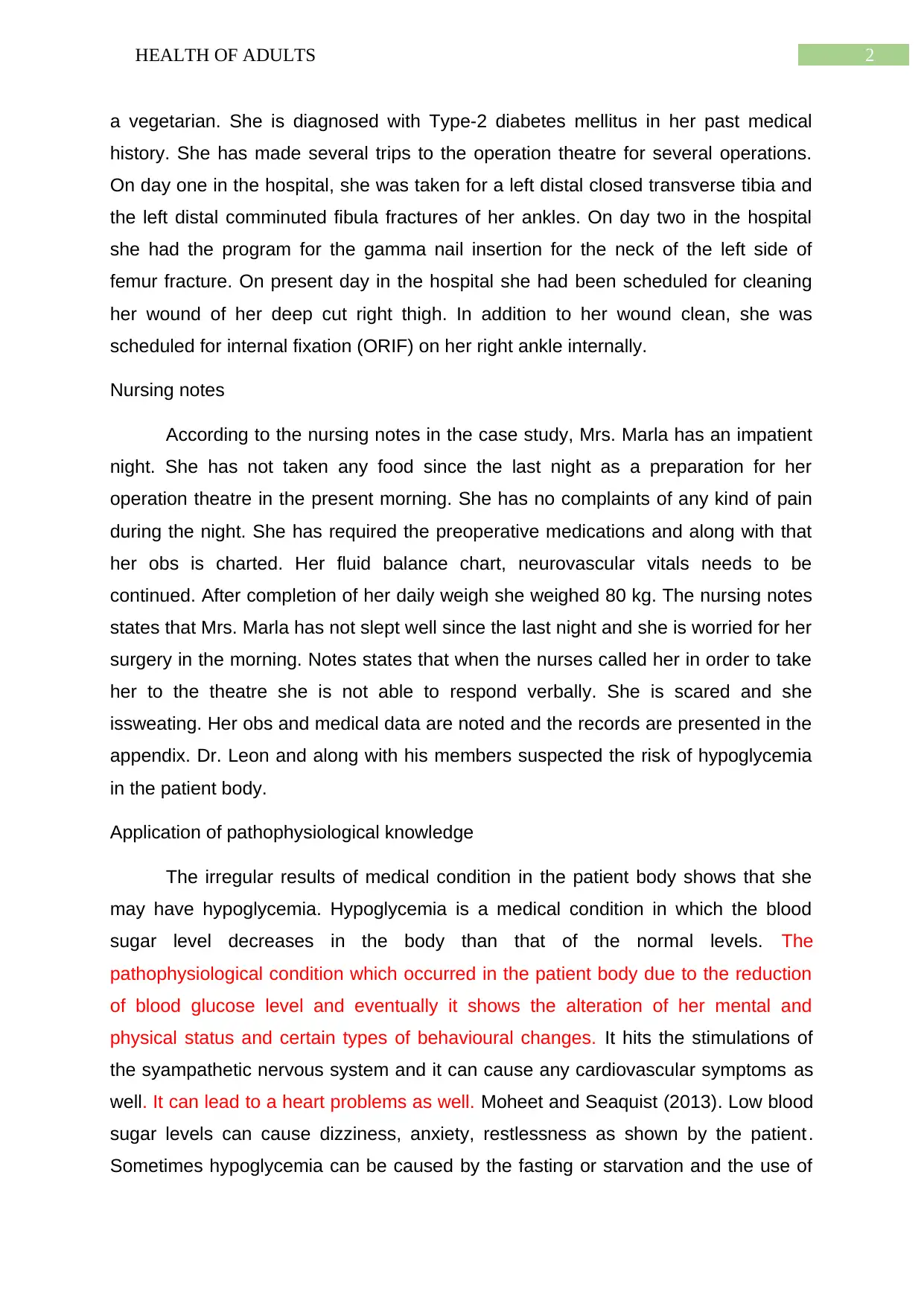
2HEALTH OF ADULTS
a vegetarian. She is diagnosed with Type-2 diabetes mellitus in her past medical
history. She has made several trips to the operation theatre for several operations.
On day one in the hospital, she was taken for a left distal closed transverse tibia and
the left distal comminuted fibula fractures of her ankles. On day two in the hospital
she had the program for the gamma nail insertion for the neck of the left side of
femur fracture. On present day in the hospital she had been scheduled for cleaning
her wound of her deep cut right thigh. In addition to her wound clean, she was
scheduled for internal fixation (ORIF) on her right ankle internally.
Nursing notes
According to the nursing notes in the case study, Mrs. Marla has an impatient
night. She has not taken any food since the last night as a preparation for her
operation theatre in the present morning. She has no complaints of any kind of pain
during the night. She has required the preoperative medications and along with that
her obs is charted. Her fluid balance chart, neurovascular vitals needs to be
continued. After completion of her daily weigh she weighed 80 kg. The nursing notes
states that Mrs. Marla has not slept well since the last night and she is worried for her
surgery in the morning. Notes states that when the nurses called her in order to take
her to the theatre she is not able to respond verbally. She is scared and she
issweating. Her obs and medical data are noted and the records are presented in the
appendix. Dr. Leon and along with his members suspected the risk of hypoglycemia
in the patient body.
Application of pathophysiological knowledge
The irregular results of medical condition in the patient body shows that she
may have hypoglycemia. Hypoglycemia is a medical condition in which the blood
sugar level decreases in the body than that of the normal levels. The
pathophysiological condition which occurred in the patient body due to the reduction
of blood glucose level and eventually it shows the alteration of her mental and
physical status and certain types of behavioural changes. It hits the stimulations of
the syampathetic nervous system and it can cause any cardiovascular symptoms as
well. It can lead to a heart problems as well. Moheet and Seaquist (2013). Low blood
sugar levels can cause dizziness, anxiety, restlessness as shown by the patient.
Sometimes hypoglycemia can be caused by the fasting or starvation and the use of
a vegetarian. She is diagnosed with Type-2 diabetes mellitus in her past medical
history. She has made several trips to the operation theatre for several operations.
On day one in the hospital, she was taken for a left distal closed transverse tibia and
the left distal comminuted fibula fractures of her ankles. On day two in the hospital
she had the program for the gamma nail insertion for the neck of the left side of
femur fracture. On present day in the hospital she had been scheduled for cleaning
her wound of her deep cut right thigh. In addition to her wound clean, she was
scheduled for internal fixation (ORIF) on her right ankle internally.
Nursing notes
According to the nursing notes in the case study, Mrs. Marla has an impatient
night. She has not taken any food since the last night as a preparation for her
operation theatre in the present morning. She has no complaints of any kind of pain
during the night. She has required the preoperative medications and along with that
her obs is charted. Her fluid balance chart, neurovascular vitals needs to be
continued. After completion of her daily weigh she weighed 80 kg. The nursing notes
states that Mrs. Marla has not slept well since the last night and she is worried for her
surgery in the morning. Notes states that when the nurses called her in order to take
her to the theatre she is not able to respond verbally. She is scared and she
issweating. Her obs and medical data are noted and the records are presented in the
appendix. Dr. Leon and along with his members suspected the risk of hypoglycemia
in the patient body.
Application of pathophysiological knowledge
The irregular results of medical condition in the patient body shows that she
may have hypoglycemia. Hypoglycemia is a medical condition in which the blood
sugar level decreases in the body than that of the normal levels. The
pathophysiological condition which occurred in the patient body due to the reduction
of blood glucose level and eventually it shows the alteration of her mental and
physical status and certain types of behavioural changes. It hits the stimulations of
the syampathetic nervous system and it can cause any cardiovascular symptoms as
well. It can lead to a heart problems as well. Moheet and Seaquist (2013). Low blood
sugar levels can cause dizziness, anxiety, restlessness as shown by the patient.
Sometimes hypoglycemia can be caused by the fasting or starvation and the use of

3HEALTH OF ADULTS
drugs can cause the disorder too. Methamphetamines can cause a change in the
blood glucose level. Mrs. Marla is starving since last night for her operation in the
theatre and it causes a fluctuation in the blood glucose levels. From her medical
reports it was seen that her blood glucose level falls the range of 50 mg/Dl. In order
to recover the glucose level in the body, doctor has prescribed a dose of glucagon.
Glucagon can cause a change in the liver function where the stored glycogen present
in the body can be converted to usable glucose. This causes an elevation of blood
glucose level in the body of Mrs. Marla (Fish et al. 2013, p. 1384)
Nursing care plan
According to Nursing and Midwifery Board of Australia, (2016), nurses and
midwives should be registered with the Nursing and Midwifery Board of Australia or
NMBA, and they should meet the NMBA’s professional standards to practice in
Australia. That nursing is the science of profession and caring together. Nursing care
is required for Mrs. Marla to curb down the case of hypoglycaemia (Clayton et al.
2013, p. 69).. Nurses and midwives should care for Mrs. Marla who had an elevated
blood glucose level. They should adopt several interventions to reduce the sugar
levels in the patient body. The nurses should administer the liquids that contain
glucose Harper and Maloney (2016). The blood glucose level should be checked in
the interval of 1 hour from the time of incorporation. If the patient body is conscious
then the nurses should administer the patient with juice which is followed by complex
carbohydrates and proteins in order to prevent the hypoglycaemia during the next
hour (Rosenstock et al. 2014). If Mrs. Marla has a reduced level of consciousness
the nurses should set up a large bore I.V. line and administer 50ml of 50% dextrose
as a bolus. If none of the above interventions are possible then the patient body
should be treated with glucagon. The oxygen is important throughout, so an airway
should be maintained Morton and Fontaine (2013). All the other vitals like the blood
pressure, heart rates should be monitored (Refer to appendix). The nurses should
provide a nasogastric tube if the patient feels uncomfortable while taking the food
(Refer to the appendix). The nurses should help Mrs. Marla to consume the food
which will give her energy. According to the case study, the patient has been
administered with 1M glucagon as a dose of 1 mg. This drug is important to treat
hypoglycaemia. I mg of standard dose of glucagon is administered in the severe case
drugs can cause the disorder too. Methamphetamines can cause a change in the
blood glucose level. Mrs. Marla is starving since last night for her operation in the
theatre and it causes a fluctuation in the blood glucose levels. From her medical
reports it was seen that her blood glucose level falls the range of 50 mg/Dl. In order
to recover the glucose level in the body, doctor has prescribed a dose of glucagon.
Glucagon can cause a change in the liver function where the stored glycogen present
in the body can be converted to usable glucose. This causes an elevation of blood
glucose level in the body of Mrs. Marla (Fish et al. 2013, p. 1384)
Nursing care plan
According to Nursing and Midwifery Board of Australia, (2016), nurses and
midwives should be registered with the Nursing and Midwifery Board of Australia or
NMBA, and they should meet the NMBA’s professional standards to practice in
Australia. That nursing is the science of profession and caring together. Nursing care
is required for Mrs. Marla to curb down the case of hypoglycaemia (Clayton et al.
2013, p. 69).. Nurses and midwives should care for Mrs. Marla who had an elevated
blood glucose level. They should adopt several interventions to reduce the sugar
levels in the patient body. The nurses should administer the liquids that contain
glucose Harper and Maloney (2016). The blood glucose level should be checked in
the interval of 1 hour from the time of incorporation. If the patient body is conscious
then the nurses should administer the patient with juice which is followed by complex
carbohydrates and proteins in order to prevent the hypoglycaemia during the next
hour (Rosenstock et al. 2014). If Mrs. Marla has a reduced level of consciousness
the nurses should set up a large bore I.V. line and administer 50ml of 50% dextrose
as a bolus. If none of the above interventions are possible then the patient body
should be treated with glucagon. The oxygen is important throughout, so an airway
should be maintained Morton and Fontaine (2013). All the other vitals like the blood
pressure, heart rates should be monitored (Refer to appendix). The nurses should
provide a nasogastric tube if the patient feels uncomfortable while taking the food
(Refer to the appendix). The nurses should help Mrs. Marla to consume the food
which will give her energy. According to the case study, the patient has been
administered with 1M glucagon as a dose of 1 mg. This drug is important to treat
hypoglycaemia. I mg of standard dose of glucagon is administered in the severe case
Secure Best Marks with AI Grader
Need help grading? Try our AI Grader for instant feedback on your assignments.
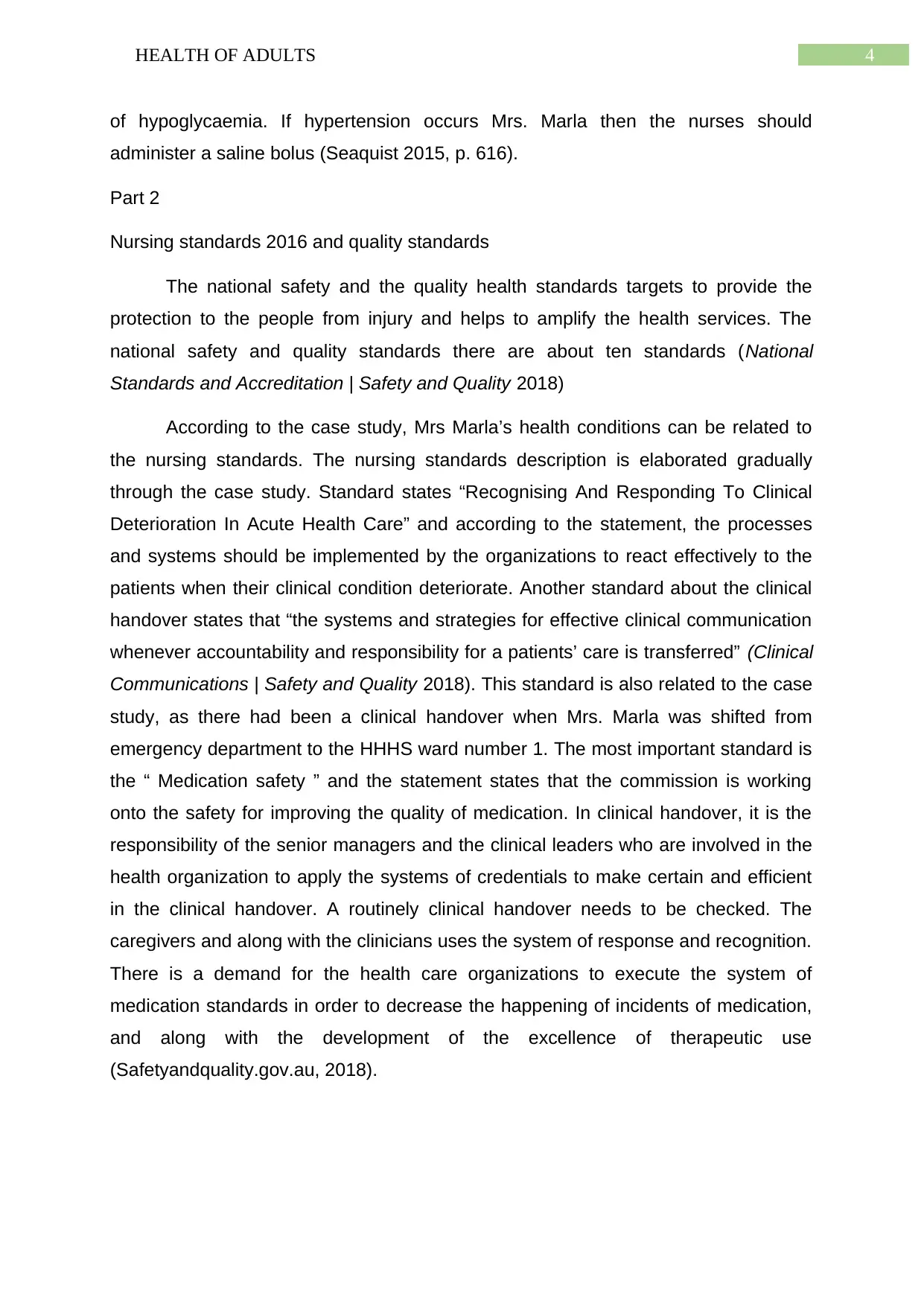
4HEALTH OF ADULTS
of hypoglycaemia. If hypertension occurs Mrs. Marla then the nurses should
administer a saline bolus (Seaquist 2015, p. 616).
Part 2
Nursing standards 2016 and quality standards
The national safety and the quality health standards targets to provide the
protection to the people from injury and helps to amplify the health services. The
national safety and quality standards there are about ten standards (National
Standards and Accreditation | Safety and Quality 2018)
According to the case study, Mrs Marla’s health conditions can be related to
the nursing standards. The nursing standards description is elaborated gradually
through the case study. Standard states “Recognising And Responding To Clinical
Deterioration In Acute Health Care” and according to the statement, the processes
and systems should be implemented by the organizations to react effectively to the
patients when their clinical condition deteriorate. Another standard about the clinical
handover states that “the systems and strategies for effective clinical communication
whenever accountability and responsibility for a patients’ care is transferred” (Clinical
Communications | Safety and Quality 2018). This standard is also related to the case
study, as there had been a clinical handover when Mrs. Marla was shifted from
emergency department to the HHHS ward number 1. The most important standard is
the “ Medication safety ” and the statement states that the commission is working
onto the safety for improving the quality of medication. In clinical handover, it is the
responsibility of the senior managers and the clinical leaders who are involved in the
health organization to apply the systems of credentials to make certain and efficient
in the clinical handover. A routinely clinical handover needs to be checked. The
caregivers and along with the clinicians uses the system of response and recognition.
There is a demand for the health care organizations to execute the system of
medication standards in order to decrease the happening of incidents of medication,
and along with the development of the excellence of therapeutic use
(Safetyandquality.gov.au, 2018).
of hypoglycaemia. If hypertension occurs Mrs. Marla then the nurses should
administer a saline bolus (Seaquist 2015, p. 616).
Part 2
Nursing standards 2016 and quality standards
The national safety and the quality health standards targets to provide the
protection to the people from injury and helps to amplify the health services. The
national safety and quality standards there are about ten standards (National
Standards and Accreditation | Safety and Quality 2018)
According to the case study, Mrs Marla’s health conditions can be related to
the nursing standards. The nursing standards description is elaborated gradually
through the case study. Standard states “Recognising And Responding To Clinical
Deterioration In Acute Health Care” and according to the statement, the processes
and systems should be implemented by the organizations to react effectively to the
patients when their clinical condition deteriorate. Another standard about the clinical
handover states that “the systems and strategies for effective clinical communication
whenever accountability and responsibility for a patients’ care is transferred” (Clinical
Communications | Safety and Quality 2018). This standard is also related to the case
study, as there had been a clinical handover when Mrs. Marla was shifted from
emergency department to the HHHS ward number 1. The most important standard is
the “ Medication safety ” and the statement states that the commission is working
onto the safety for improving the quality of medication. In clinical handover, it is the
responsibility of the senior managers and the clinical leaders who are involved in the
health organization to apply the systems of credentials to make certain and efficient
in the clinical handover. A routinely clinical handover needs to be checked. The
caregivers and along with the clinicians uses the system of response and recognition.
There is a demand for the health care organizations to execute the system of
medication standards in order to decrease the happening of incidents of medication,
and along with the development of the excellence of therapeutic use
(Safetyandquality.gov.au, 2018).
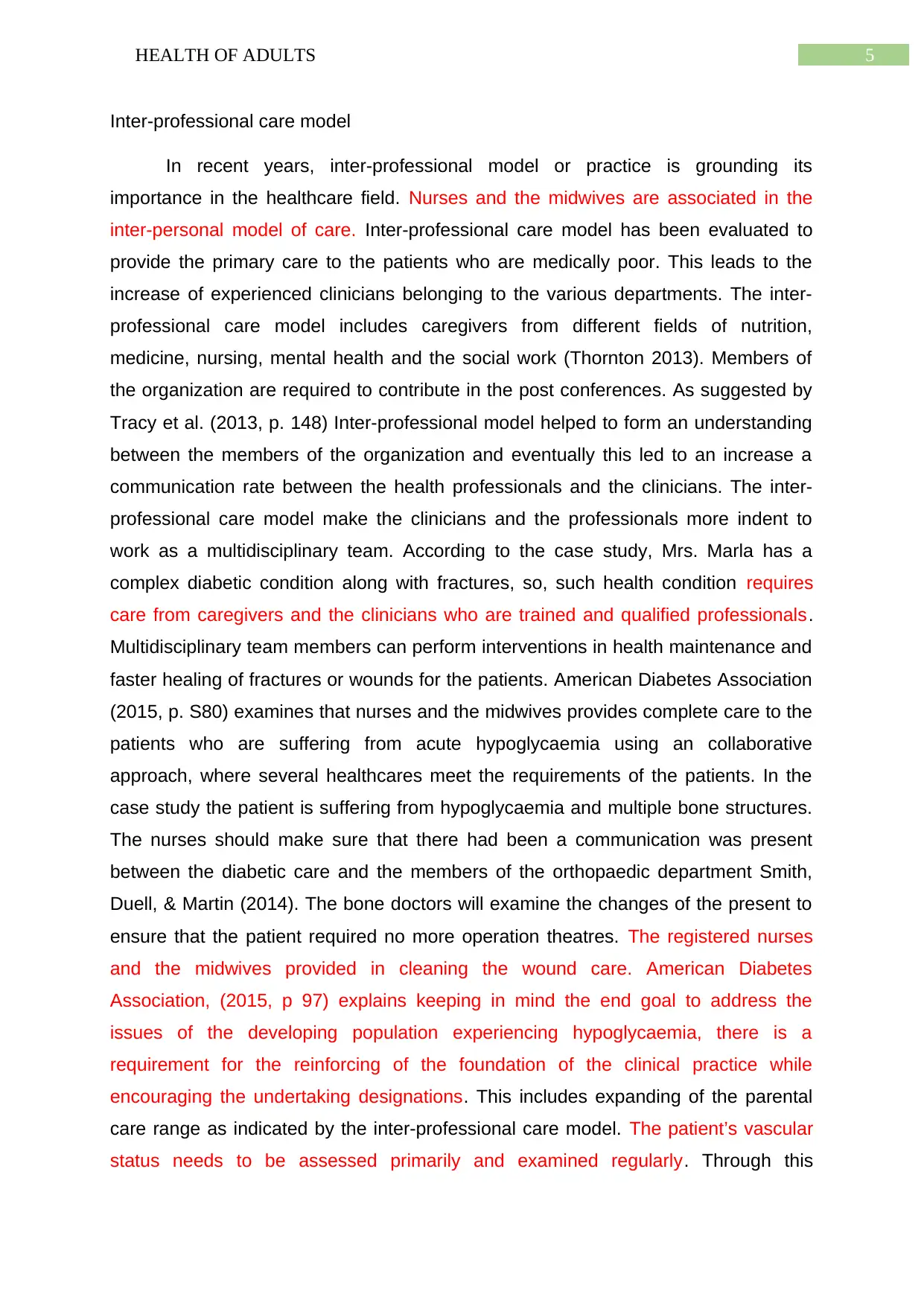
5HEALTH OF ADULTS
Inter-professional care model
In recent years, inter-professional model or practice is grounding its
importance in the healthcare field. Nurses and the midwives are associated in the
inter-personal model of care. Inter-professional care model has been evaluated to
provide the primary care to the patients who are medically poor. This leads to the
increase of experienced clinicians belonging to the various departments. The inter-
professional care model includes caregivers from different fields of nutrition,
medicine, nursing, mental health and the social work (Thornton 2013). Members of
the organization are required to contribute in the post conferences. As suggested by
Tracy et al. (2013, p. 148) Inter-professional model helped to form an understanding
between the members of the organization and eventually this led to an increase a
communication rate between the health professionals and the clinicians. The inter-
professional care model make the clinicians and the professionals more indent to
work as a multidisciplinary team. According to the case study, Mrs. Marla has a
complex diabetic condition along with fractures, so, such health condition requires
care from caregivers and the clinicians who are trained and qualified professionals.
Multidisciplinary team members can perform interventions in health maintenance and
faster healing of fractures or wounds for the patients. American Diabetes Association
(2015, p. S80) examines that nurses and the midwives provides complete care to the
patients who are suffering from acute hypoglycaemia using an collaborative
approach, where several healthcares meet the requirements of the patients. In the
case study the patient is suffering from hypoglycaemia and multiple bone structures.
The nurses should make sure that there had been a communication was present
between the diabetic care and the members of the orthopaedic department Smith,
Duell, & Martin (2014). The bone doctors will examine the changes of the present to
ensure that the patient required no more operation theatres. The registered nurses
and the midwives provided in cleaning the wound care. American Diabetes
Association, (2015, p 97) explains keeping in mind the end goal to address the
issues of the developing population experiencing hypoglycaemia, there is a
requirement for the reinforcing of the foundation of the clinical practice while
encouraging the undertaking designations. This includes expanding of the parental
care range as indicated by the inter-professional care model. The patient’s vascular
status needs to be assessed primarily and examined regularly. Through this
Inter-professional care model
In recent years, inter-professional model or practice is grounding its
importance in the healthcare field. Nurses and the midwives are associated in the
inter-personal model of care. Inter-professional care model has been evaluated to
provide the primary care to the patients who are medically poor. This leads to the
increase of experienced clinicians belonging to the various departments. The inter-
professional care model includes caregivers from different fields of nutrition,
medicine, nursing, mental health and the social work (Thornton 2013). Members of
the organization are required to contribute in the post conferences. As suggested by
Tracy et al. (2013, p. 148) Inter-professional model helped to form an understanding
between the members of the organization and eventually this led to an increase a
communication rate between the health professionals and the clinicians. The inter-
professional care model make the clinicians and the professionals more indent to
work as a multidisciplinary team. According to the case study, Mrs. Marla has a
complex diabetic condition along with fractures, so, such health condition requires
care from caregivers and the clinicians who are trained and qualified professionals.
Multidisciplinary team members can perform interventions in health maintenance and
faster healing of fractures or wounds for the patients. American Diabetes Association
(2015, p. S80) examines that nurses and the midwives provides complete care to the
patients who are suffering from acute hypoglycaemia using an collaborative
approach, where several healthcares meet the requirements of the patients. In the
case study the patient is suffering from hypoglycaemia and multiple bone structures.
The nurses should make sure that there had been a communication was present
between the diabetic care and the members of the orthopaedic department Smith,
Duell, & Martin (2014). The bone doctors will examine the changes of the present to
ensure that the patient required no more operation theatres. The registered nurses
and the midwives provided in cleaning the wound care. American Diabetes
Association, (2015, p 97) explains keeping in mind the end goal to address the
issues of the developing population experiencing hypoglycaemia, there is a
requirement for the reinforcing of the foundation of the clinical practice while
encouraging the undertaking designations. This includes expanding of the parental
care range as indicated by the inter-professional care model. The patient’s vascular
status needs to be assessed primarily and examined regularly. Through this
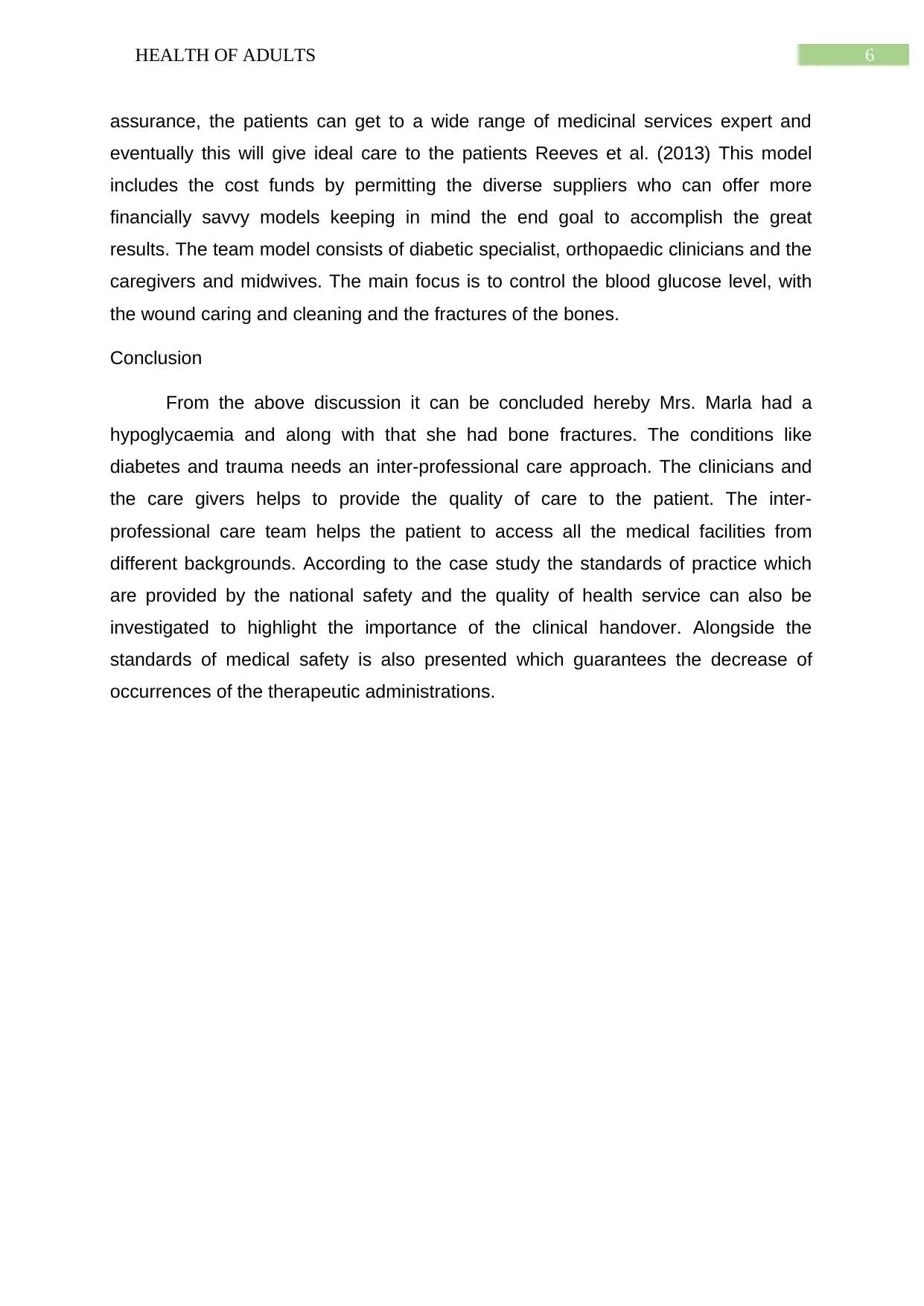
6HEALTH OF ADULTS
assurance, the patients can get to a wide range of medicinal services expert and
eventually this will give ideal care to the patients Reeves et al. (2013) This model
includes the cost funds by permitting the diverse suppliers who can offer more
financially savvy models keeping in mind the end goal to accomplish the great
results. The team model consists of diabetic specialist, orthopaedic clinicians and the
caregivers and midwives. The main focus is to control the blood glucose level, with
the wound caring and cleaning and the fractures of the bones.
Conclusion
From the above discussion it can be concluded hereby Mrs. Marla had a
hypoglycaemia and along with that she had bone fractures. The conditions like
diabetes and trauma needs an inter-professional care approach. The clinicians and
the care givers helps to provide the quality of care to the patient. The inter-
professional care team helps the patient to access all the medical facilities from
different backgrounds. According to the case study the standards of practice which
are provided by the national safety and the quality of health service can also be
investigated to highlight the importance of the clinical handover. Alongside the
standards of medical safety is also presented which guarantees the decrease of
occurrences of the therapeutic administrations.
assurance, the patients can get to a wide range of medicinal services expert and
eventually this will give ideal care to the patients Reeves et al. (2013) This model
includes the cost funds by permitting the diverse suppliers who can offer more
financially savvy models keeping in mind the end goal to accomplish the great
results. The team model consists of diabetic specialist, orthopaedic clinicians and the
caregivers and midwives. The main focus is to control the blood glucose level, with
the wound caring and cleaning and the fractures of the bones.
Conclusion
From the above discussion it can be concluded hereby Mrs. Marla had a
hypoglycaemia and along with that she had bone fractures. The conditions like
diabetes and trauma needs an inter-professional care approach. The clinicians and
the care givers helps to provide the quality of care to the patient. The inter-
professional care team helps the patient to access all the medical facilities from
different backgrounds. According to the case study the standards of practice which
are provided by the national safety and the quality of health service can also be
investigated to highlight the importance of the clinical handover. Alongside the
standards of medical safety is also presented which guarantees the decrease of
occurrences of the therapeutic administrations.
Paraphrase This Document
Need a fresh take? Get an instant paraphrase of this document with our AI Paraphraser

7HEALTH OF ADULTS
References
American Diabetes Association, 2015. 13. Diabetes care in the hospital, nursing
home, and skilled nursing facility. Diabetes Care, 38(Supplement 1), pp.S80-S85.
American Diabetes Association, 2015. Standards of medical care in diabetes—2015
abridged for primary care providers. Clinical diabetes: a publication of the American
Diabetes Association, 33(2), p.97.
Clinical Communications | Safety and Quality 2018, Retrieved from
<https://www.safetyandquality.gov.au/our-work/clinical-communications/>.
Clayton, Dale, Vincent Woo, and Jean-François Yale. "Hypoglycemia." Canadian
journal of diabetes 37 (2013): S69-S71.
Fish, L., Heller, S.R., Rodriguez, H., Rosenzweig, J. and Vigersky, R., 2013.
Hypoglycemia and diabetes. Diabetes Care, 36(5), pp.1384-1395.
Harper, M.G. & Maloney, P. eds., 2016. Nursing professional development: Scope
and standards of practice. Association for Nursing Professional Development.
Moheet, A. & Seaquist, E.R., 2013. Hypoglycemia as a driver of cardiovascular risk in
diabetes. Current atherosclerosis reports, 15(9), p.351.
Morton, P.G. & Fontaine, D.K., 2013. Essentials of critical care nursing. Wolters
Kluwer Health/Lippincott Williams & Wilkins,.
Nursing and Midwifery Board of Australia, 2016. Registered nurse standards for
practice.
References
American Diabetes Association, 2015. 13. Diabetes care in the hospital, nursing
home, and skilled nursing facility. Diabetes Care, 38(Supplement 1), pp.S80-S85.
American Diabetes Association, 2015. Standards of medical care in diabetes—2015
abridged for primary care providers. Clinical diabetes: a publication of the American
Diabetes Association, 33(2), p.97.
Clinical Communications | Safety and Quality 2018, Retrieved from
<https://www.safetyandquality.gov.au/our-work/clinical-communications/>.
Clayton, Dale, Vincent Woo, and Jean-François Yale. "Hypoglycemia." Canadian
journal of diabetes 37 (2013): S69-S71.
Fish, L., Heller, S.R., Rodriguez, H., Rosenzweig, J. and Vigersky, R., 2013.
Hypoglycemia and diabetes. Diabetes Care, 36(5), pp.1384-1395.
Harper, M.G. & Maloney, P. eds., 2016. Nursing professional development: Scope
and standards of practice. Association for Nursing Professional Development.
Moheet, A. & Seaquist, E.R., 2013. Hypoglycemia as a driver of cardiovascular risk in
diabetes. Current atherosclerosis reports, 15(9), p.351.
Morton, P.G. & Fontaine, D.K., 2013. Essentials of critical care nursing. Wolters
Kluwer Health/Lippincott Williams & Wilkins,.
Nursing and Midwifery Board of Australia, 2016. Registered nurse standards for
practice.
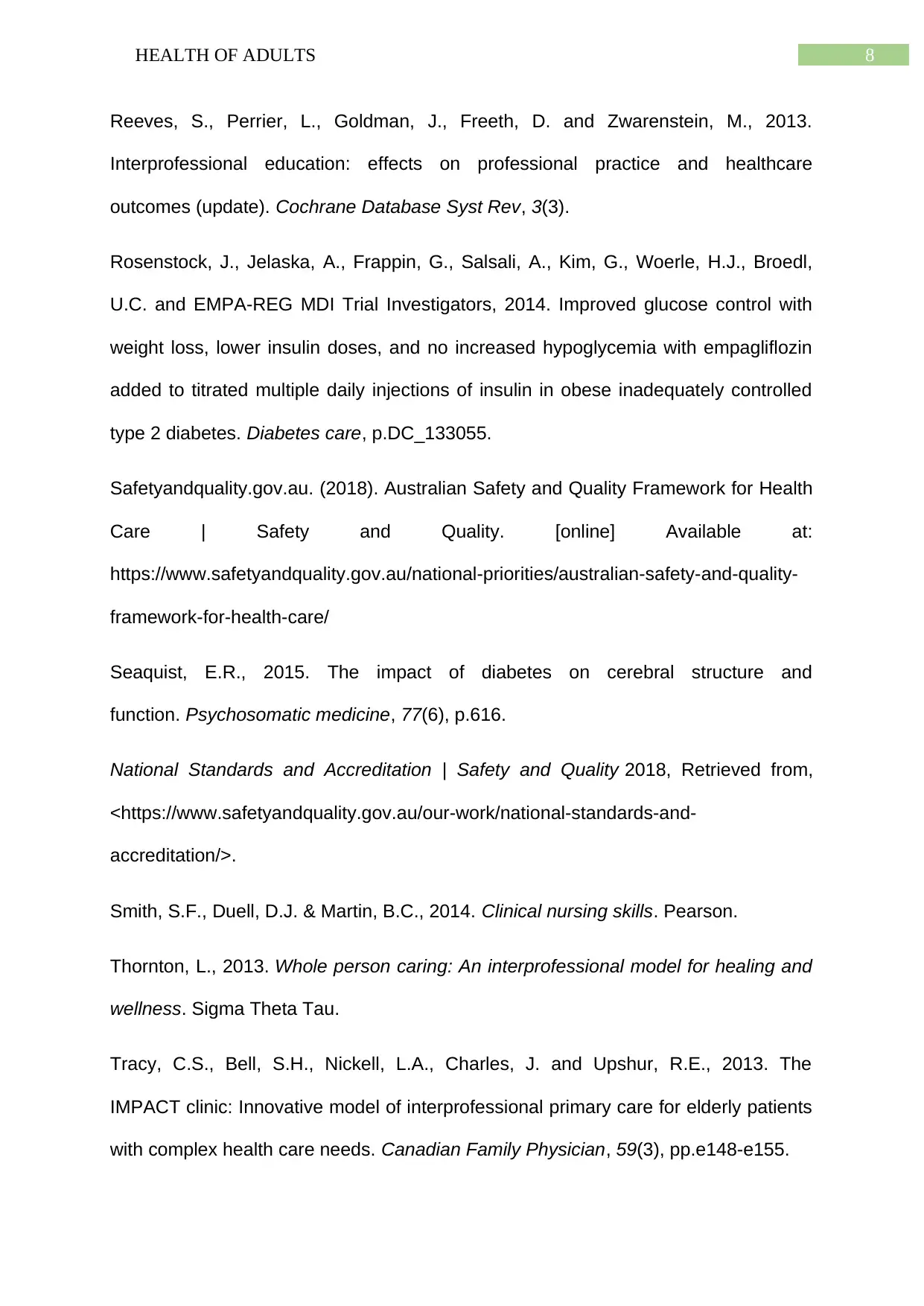
8HEALTH OF ADULTS
Reeves, S., Perrier, L., Goldman, J., Freeth, D. and Zwarenstein, M., 2013.
Interprofessional education: effects on professional practice and healthcare
outcomes (update). Cochrane Database Syst Rev, 3(3).
Rosenstock, J., Jelaska, A., Frappin, G., Salsali, A., Kim, G., Woerle, H.J., Broedl,
U.C. and EMPA-REG MDI Trial Investigators, 2014. Improved glucose control with
weight loss, lower insulin doses, and no increased hypoglycemia with empagliflozin
added to titrated multiple daily injections of insulin in obese inadequately controlled
type 2 diabetes. Diabetes care, p.DC_133055.
Safetyandquality.gov.au. (2018). Australian Safety and Quality Framework for Health
Care | Safety and Quality. [online] Available at:
https://www.safetyandquality.gov.au/national-priorities/australian-safety-and-quality-
framework-for-health-care/
Seaquist, E.R., 2015. The impact of diabetes on cerebral structure and
function. Psychosomatic medicine, 77(6), p.616.
National Standards and Accreditation | Safety and Quality 2018, Retrieved from,
<https://www.safetyandquality.gov.au/our-work/national-standards-and-
accreditation/>.
Smith, S.F., Duell, D.J. & Martin, B.C., 2014. Clinical nursing skills. Pearson.
Thornton, L., 2013. Whole person caring: An interprofessional model for healing and
wellness. Sigma Theta Tau.
Tracy, C.S., Bell, S.H., Nickell, L.A., Charles, J. and Upshur, R.E., 2013. The
IMPACT clinic: Innovative model of interprofessional primary care for elderly patients
with complex health care needs. Canadian Family Physician, 59(3), pp.e148-e155.
Reeves, S., Perrier, L., Goldman, J., Freeth, D. and Zwarenstein, M., 2013.
Interprofessional education: effects on professional practice and healthcare
outcomes (update). Cochrane Database Syst Rev, 3(3).
Rosenstock, J., Jelaska, A., Frappin, G., Salsali, A., Kim, G., Woerle, H.J., Broedl,
U.C. and EMPA-REG MDI Trial Investigators, 2014. Improved glucose control with
weight loss, lower insulin doses, and no increased hypoglycemia with empagliflozin
added to titrated multiple daily injections of insulin in obese inadequately controlled
type 2 diabetes. Diabetes care, p.DC_133055.
Safetyandquality.gov.au. (2018). Australian Safety and Quality Framework for Health
Care | Safety and Quality. [online] Available at:
https://www.safetyandquality.gov.au/national-priorities/australian-safety-and-quality-
framework-for-health-care/
Seaquist, E.R., 2015. The impact of diabetes on cerebral structure and
function. Psychosomatic medicine, 77(6), p.616.
National Standards and Accreditation | Safety and Quality 2018, Retrieved from,
<https://www.safetyandquality.gov.au/our-work/national-standards-and-
accreditation/>.
Smith, S.F., Duell, D.J. & Martin, B.C., 2014. Clinical nursing skills. Pearson.
Thornton, L., 2013. Whole person caring: An interprofessional model for healing and
wellness. Sigma Theta Tau.
Tracy, C.S., Bell, S.H., Nickell, L.A., Charles, J. and Upshur, R.E., 2013. The
IMPACT clinic: Innovative model of interprofessional primary care for elderly patients
with complex health care needs. Canadian Family Physician, 59(3), pp.e148-e155.

9HEALTH OF ADULTS
Secure Best Marks with AI Grader
Need help grading? Try our AI Grader for instant feedback on your assignments.

10HEALTH OF ADULTS
Appendix
Insulin and the blood glucose record
Appendix
Insulin and the blood glucose record
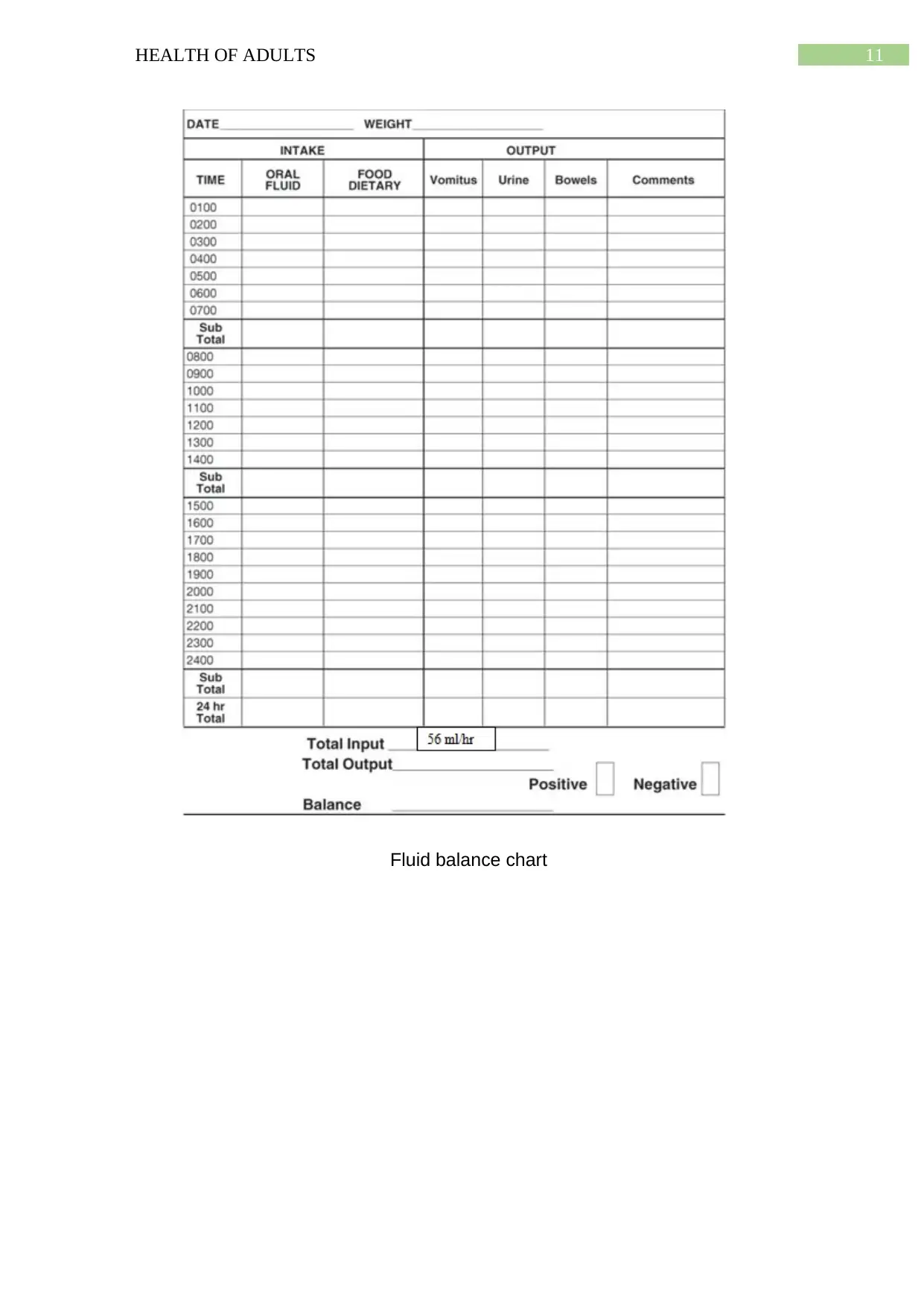
11HEALTH OF ADULTS
Fluid balance chart
Fluid balance chart

12HEALTH OF ADULTS
Oxygen chart
Oxygen chart
1 out of 13
Related Documents
Your All-in-One AI-Powered Toolkit for Academic Success.
+13062052269
info@desklib.com
Available 24*7 on WhatsApp / Email
![[object Object]](/_next/static/media/star-bottom.7253800d.svg)
Unlock your academic potential
© 2024 | Zucol Services PVT LTD | All rights reserved.




